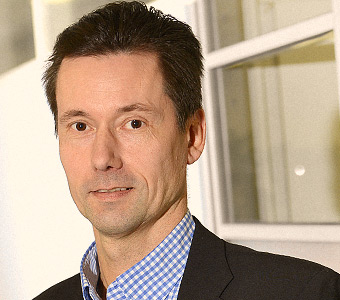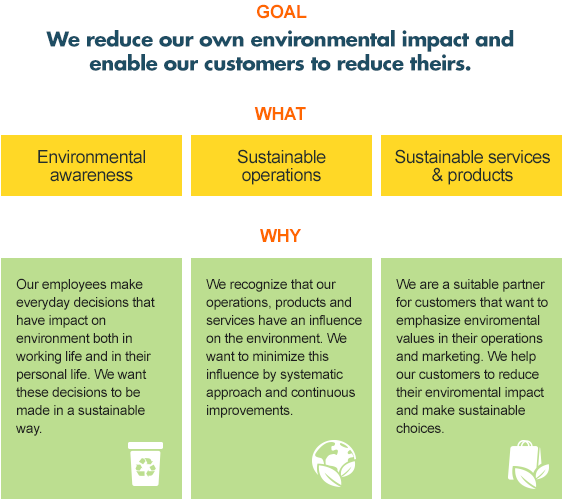Environmental responsibility

Mika Ruuskanen, Director, the Green Nordic Morning program
Achievements in 2014
We continued our determined and goal-oriented efforts to develop environmental responsibility.
The Green Office system was expanded in 2014 to include Klikki offices in Helsinki, Stockholm and Piteå. The WWF granted Klikkicom’s Helsinki office the right to use the Green Office label in April, followed by Klikki’s Stockholm and Piteå offices in June.
Both of Nordic Morning’s printing companies, Edita Prima Ltd in Finland and Edita Bobergs AB in Sweden, renewed their Nordic Ecolabel licenses to match the new and more stringent permit criteria. As a result of the stricter criteria, the number of Ecolabel-certified printing houses in Finland fell to approximately half of the previous amount.
Measures to improve energy-efficiency continued. The lighting system at the head office in Helsinki was replaced by a more energy-efficient system that uses LED lights.
Edita Bobergs won first prize in the Ride a Bicycle to Work campaign organized by the city of Västerås. During the competition period (April 22 to May 25), as much as 44 percent of the commuting to Edita Bobergs’ Västerås office was done by bicycle.

Measuring the digital eco footprint
Mika Ruuskanen, Director, the Green Nordic Morning program:
"Currently, Nordic Morning can calculate the energy consumption of its offices, computers and its own servers."

Green Office makes environmental work a joint effort
Petra Lilius, the person responsible for the Green Office program, Klikki
"The organization’s shared vision is a precondition for long-term environmental work. Cooperation with the WWF’s Green Office program has made environmental work a joint effort for the personnel and one that increases solidarity."

The eco footprint of clicking
Hanna Pihkola, a researcher at the VTT Technical Research Centre of Finland:
"We need more cooperation between the various actors to promote the life cycle environmental impact of digital services."
Environmental targets
We will reduce our carbon footprint by 40 percent compared with 2008.
This means that:
- all of our production plants and offices will use green electricity
- we will have a unified travel and car policy
- we will have a unified method for calculating emissions. Our calculations will include fuel, energy consumption, business travel and transport
All of our companies will have a certified environmental program:
- all of our printing facilities will be ISO 14001 certified
- all of our offices will be WWF Green Office certified
- all of our production plants will have the right to use the Nordic Ecolabel
- all of our production plants will be FSC certified.
We increase environmental awareness among our employees, customers and suppliers of goods and services every year:
- we publish the results of our environmental work in our annual corporate responsibility report
- the themes and goals of our environmental work are kept up-to-date and available to everyone on our intranet
- we provide our customers with products that carry the Nordic Ecolabel and that are FSC certified
- more than 90 percent of our staff will consider it important for Nordic Morning to be a leading company in environmental matters
- we have set environmental criteria for the stages of the supply chain that have the largest environmental impact.
Our environmental strategy

Products and services 2014
To reduce their environmental impact, companies must choose the right materials and production methods. We recommend the use of internationally recognized labels to our customers, as they send a visible message about environmental responsibility.
The Nordic Ecolabel
The environmental impact of printed products has been considered throughout the production chain, from paper manufacturing to the delivery of the finished product. The printed product fulfills the Nordic Ecolabel’s standards for forest management, pulp and paper manufacturing, printing and waste management.
Nordic Morning’s production plants have been granted the right to use the Nordic Ecolabel. The Group's net revenue from products carrying the Nordic Ecolabel was about EUR 2.5 million in 2014.
Guarantees of origin – paper
Forest certification ensures that forests are managed according to agreed criteria and that the wood fiber used is monitored from forest to finished product.
Ecological footprint
For several years, Nordic Morning has been surveying the environmental impact created by its printed products. This ecological footprint describes the environmental impact and carbon footprint of a printed product. We now have a software application with which we can calculate the carbon footprint of an individual printed product more accurately.
The forest management criteria apply to matters such as:
- compliance with national laws and international agreements
- respect for the rights of indigenous peoples and of workers
- maintaining the biodiversity of forests
- preserving forests with a significant environmental protection value.
The processes we engage in at Nordic Morning’s production plants to track down the source of paper are certified according to international reference standards. For this reason, our printing companies are entitled to use labels showing that our paper originates from a responsibly chosen source. The Group’s net revenue of printed products with Chain of Custody (CoC) labels was about EUR 1.5 million in 2014.
Supply chain
From the perspective of environmental responsibility, Nordic Morning’s most significant purchases are those related to the paper and electricity supply chains. We will not procure paper that originates from illegal felling or forests with a significant environmental protection value.
We adhere to the following principles when procuring paper:
- we will scrutinize the environmental responsibility programs and wood procurement principles of paper suppliers
- we will prioritize paper that carries the Nordic Ecolabel and is CoC certified
- we will increase the amount of CoC-certified paper procured year on year (2 593 tons in 2014)
- we will prioritize paper that is manufactured in the Nordic countries.
- Nordic Morning’s production sites solely use energy generated from renewable sources. The Falun and Västra Aros production facilities use hydroelectric power and wind power, and the Helsinki production facility uses hydroelectric power and wood-based biofuels. The goal is that all of the Group companies will use electricity generated from renewable sources.
Nordic Morning’s main production sites only use energy generated from renewable sources. The Falun production facility uses hydroelectric power and the Helsinki production facility uses hydroelectric power and wood-based biofuels. The goal is that all of the Group companies will use electricity generated from renewable sources.
Chemicals used in printing carry the Nordic Ecolabel. Before introducing a new chemical into the process, its right to carry the Nordic Ecolabel will always be checked with the organization that grants the right to use the label.
Environmentally responsible operations
Offices
In office work, most of our environmental impact comes from energy consumption, paper usage and carbon-dioxide emissions caused by travel. In 2010, we began investing in determined efforts to reduce the environmental impact of the Group companies’ offices.
In 2014, the Green Office system was in use at Nordic Morning’s head office and Edita Publishing in Helsinki, the JG Communication office in Stockholm, Citat’s offices in Helsinki and Stockholm, and the Klikki offices in Helsinki, Stockholm and Piteå. Nordic Morning’s offices in Stockholm will move to new shared premises in 2015. The aim is to build a shared Green Office system for the entire office in 2015.
Printing houses
The environmental systems for our production activities ensure that our environmental work is systematic and focused on continuous improvement. The systems also ensure that we follow current environmental legislation. Nordic Morning’s production plants in Helsinki and Falun are certified in accordance with the ISO 14001 standard for environmental management.
In our production activities, the main sources of environmental impact are materials, energy, waste, and emissions. We began measuring our waste volumes regularly in the 1990s. In 2014, around 88 percent of the total waste volume was recyclable. Over the past decade, the volume of waste that has been sorted separately has increased, but it has become possible to recycle a larger range of materials.
We have positive cash flow from our waste disposal activities: the amount of waste sold brings in more funds than the amount paid for waste disposal.
In Edita Prima, investments to improve energy-efficiency continued in 2014. The compressors for the pneumatic system used in production were replaced by a single new automated compressor that offers a substantial improvement in energy-efficiency. Energy efficiency was also improved by making more efficient use of space. At Nordic Morning’s production sites, energy is used to operate machines and equipment, as well as for heating, lighting and ventilation of the premises. All of the Group’s production sites use district heating, and all Group companies use the municipal water supply as their only source of water.
Edita Prima also achieved significantly lower relative consumption of solvents during the year. This was primarily the result of replacing the isopropyl alcohol used for printing machines with a new substance that has a lower solvent content.
Climate neutrality
In autumn 2008, Nordic Morning began measuring the Group’s total carbon-dioxide emissions. We set a target of reducing emissions by 40 percent by 2015.
One important step in reducing our carbon footprint has been the transition to electricity from renewable sources (green electricity) by all printing companies. In 2014, Edita Prima and Edita Bobergs were climate-neutral. They compensate for the remaining emissions by funding UN-supervised clean development mechanism projects in India.
Environmental awareness
As a company in the communications sector, we have a particular responsibility for promoting environmental awareness among our stakeholders. We aim to ensure that the day-to-day decisions made by the Group’s employees comply with the principles of sustainable development both at work and at home.
We help our customers find solutions that are as sustainable as possible. We use communications channels such as the www.ekojulkaisu.fi website to present information on how environmental issues should be considered in the various phases of designing and producing printed materials.
Energy and water consumption at Nordic Morning's production sites
Electricity (MWh)
Heating (MWh)
Water (m3)
Consumption of materials at Nordic Morning's productions sites
Paper (tonnes)
Printing ink (tonnes)
Solvents (tonnes)
Trend in waste from Nordic Morning's production sites
Recycled (tonnes)
Recovered (tonnes)
Hazardous waste (tonnes)
Waste at Nordic Morning's production sites 2014
CO2-emissions (CO2-tonnes)
CO2-emissions
(CO2 tonnes)
| 2007 | 2008 | 2009 | 2010 | 2011 | 2012 | 2013 | 2014 | |
|---|---|---|---|---|---|---|---|---|
| Edita Prima Oy | 2792 | 2792 | 850 | 860 | 629 | 576 | 433 | 373 |
| Edita Västra Aros AB | 300 | 244 | 311 | 358 | 355 | 291 | 211 | 0 |
| Edita Bobergs AB | 186 | |||||||
| Citat AB | 125 | 125 | 125 | 60 | 106 | 174 | 109 | 139 |
| Klikki AB | 99 | 50 | ||||||
| Nordic Morning Oyj | 59 | 59 | 59 | 51 | 58 | 66 | 57 | 56 |
| Edita Publishing Oy | 95 | 95 | 95 | 87 | 47 | 46 | 43 | 46 |
| Opetusalan koulutuskeskus Educode Oy | 34 | 23 | ||||||
| JG Communication Ab | 112 | 112 | 112 | 116 | 68 | 40 | 32 | 20 |
| Klikkicom Oy | 30 | 28 | ||||||
| Citat Oy | 21 | 21 | 21 | 21 | 21 | 22 | 25 | 19 |
| Mods Graphic Studio AB | 10 | 10 | 10 | 11 | 12 | 6 | 14 | 14 |
| Total | 3514 | 3458 | 1583 | 1564 | 1296 | 1222 | 1088 | 954 |
Employees commuting between home and the workplace is not included in the calculations.
2014: Edita Prima Oy's and Edita Bobergs AB's calculations are verified.
Corporate carbon Inventory
| Emission class | Source | 2007 | 2008 | 2009 | 2010 | 2011 | 2012 | 2013 | 2014 |
|---|---|---|---|---|---|---|---|---|---|
| Scope 1 Direct Greenhouse Gas emissions | |||||||||
| EN 16 Direct and indirect Greenhouse Gas | Greenhouse Gas other climate impacts | 6.1 | 6.1 | 6.1 | 15.8 | 13.0 | 0.0 | 37.6 | 8.2 |
| EN 16 Direct and indirect Greenhouse Gas | Greenhouse Gas heating oil | 0.0 | 0.0 | 0.8 | 8.1 | 6.7 | 0.0 | 0.0 | 0.0 |
| EN 16 Direct and indirect Greenhouse Gas | Greenhouse Gas transport fuels, petrol | 100.4 | 96.8 | 86.3 | 80.7 | 52.0 | 43.8 | 35 | 34.6 |
| EN 16 Direct and indirect Greenhouse Gas | Greenhouse Gase transport fuels, diesel | 25.2 | 27.1 | 31.5 | 33.2 | 45.3 | 67.7 | 59.7 | 102.7 |
| Greenhouse Gas Protocol Scope 1, total | Direct Greenhouse total | 131.7 | 130.0 | 124.7 | 137.7 | 117.0 | 111.5 | 132.3 | 145.5 |
| Scope 2 Greenhouse Gas emissions from indirect energy | |||||||||
| EN 16 Direct and indirect Greenhouse Gas | Greenhouse Gas other climate impacts | 9.6 | 9.6 | 38.2 | 53.5 | 2.6 | 7.5 | 5.5 | 73.7 |
| EN 16 Direct and indirect Greenhouse Gas | Greenhouse Gas purchased district cooling | 0.9 | 0.9 | 0.9 | 1.4 | 1.9 | 1.7 | 1.0 | 1.0 |
| EN 16 Direct and indirect Greenhouse Gas | Greenhouse Gas purchased district heating | 514.1 | 516.4 | 580.9 | 616.3 | 529.7 | 528.2 | 442.1 | 255.2 |
| EN 16 Direct and indirect Greenhouse Gas | Greenhouse Gas purchased eco-labelled electricity | 2.1 | 2.0 | 8.8 | 6.6 | 5.3 | 4.6 | 3.5 | 0.3 |
| EN 16 Direct and indirect Greenhouse Gas | Greenhouse Gas purchased electricity | 2036.0 | 2036.3 | 54.7 | 75.4 | 69.8 | 59.3 | 31.3 | 57.2 |
| Greenhouse Gas Protocol Scope 2, total | 2562.7 | 2565.2 | 683.5 | 753.2 | 609.3 | 601.2 | 483.4 | 387.4 | |
| EN 16 Direct and indirect Greenhouse Gas | 2694.4 | 2695.2 | 808.2 | 890.9 | 726.3 | 712.8 | 615.7 | 532.9 | |
| Scope 3 Other indirect Greenhouse Gas emissions | |||||||||
| EN 17 Other indirect Greenhouse Gas | Business travel: flights | 345.6 | 344.6 | 247.5 | 207.8 | 206.3 | 235.9 | 291.0 | 216.9 |
| EN 17 Other indirect Greenhouse Gas | Business travel: others | 3.6 | 3.7 | 2.2 | 1.7 | 2.4 | 1.8 | 3.8 | 2.1 |
| EN 17 Other indirect Greenhouse Gas | Business travel: taxi, private car or rental car | 61.4 | 68.6 | 62.1 | 46.2 | 48.5 | 52.2 | 63.3 | 32.2 |
| EN 17 Other indirect Greenhouse Gas | Transportations of finished products | 408.2 | 345.7 | 462.5 | 417.2 | 312.9 | 226.9 | 105.7. | 168.3 |
| Green House Gas Protocol Scope 3, total | 818.8 | 762.6 | 774.3 | 673.0 | 570.1 | 516.8 | 463.8 | 419.5 | |
| EN 17 Other indirect Greenhous Gas, total | 818.8 | 762.6 | 774.3 | 673.0 | 570.1 | 516.8 | 463.8 | 419.5 | |
| Greenhouse Gas Protocol Scope 1, 2, 3, total | 3513.2 | 3457.8 | 1582.5 | 1563.8 | 1296.4 | 1229.6 | 1079.5 | 952.4 | |
How we reduce our carbon footprint
- our printing companies use electricity generated from renewable sources
- we increase the efficiency of our production and office facilities by merging sites
- we have discontinued the most carbon-intensive production operations
- we invest in improving energy-efficiency; for example, lighting systems have been replaced at production facilities and the head office
- we reduce business travel by using video conferencing
- we link workstations to a remote fire-extinguishing system
- we use leasing cars that are less harmful to the environment
- the Group travel policy encourages employees to make environmentally friendly decisions on business trips: the Group companies have offered employees choices such as subsidized public transport tickets and rental city bikes
- we compensate for carbon-dioxide emissions by funding UN-supervised clean development mechanism projects
- we use transport services in Finland that are environmentally compensated for
- we provide training on environmental issues to employees.
